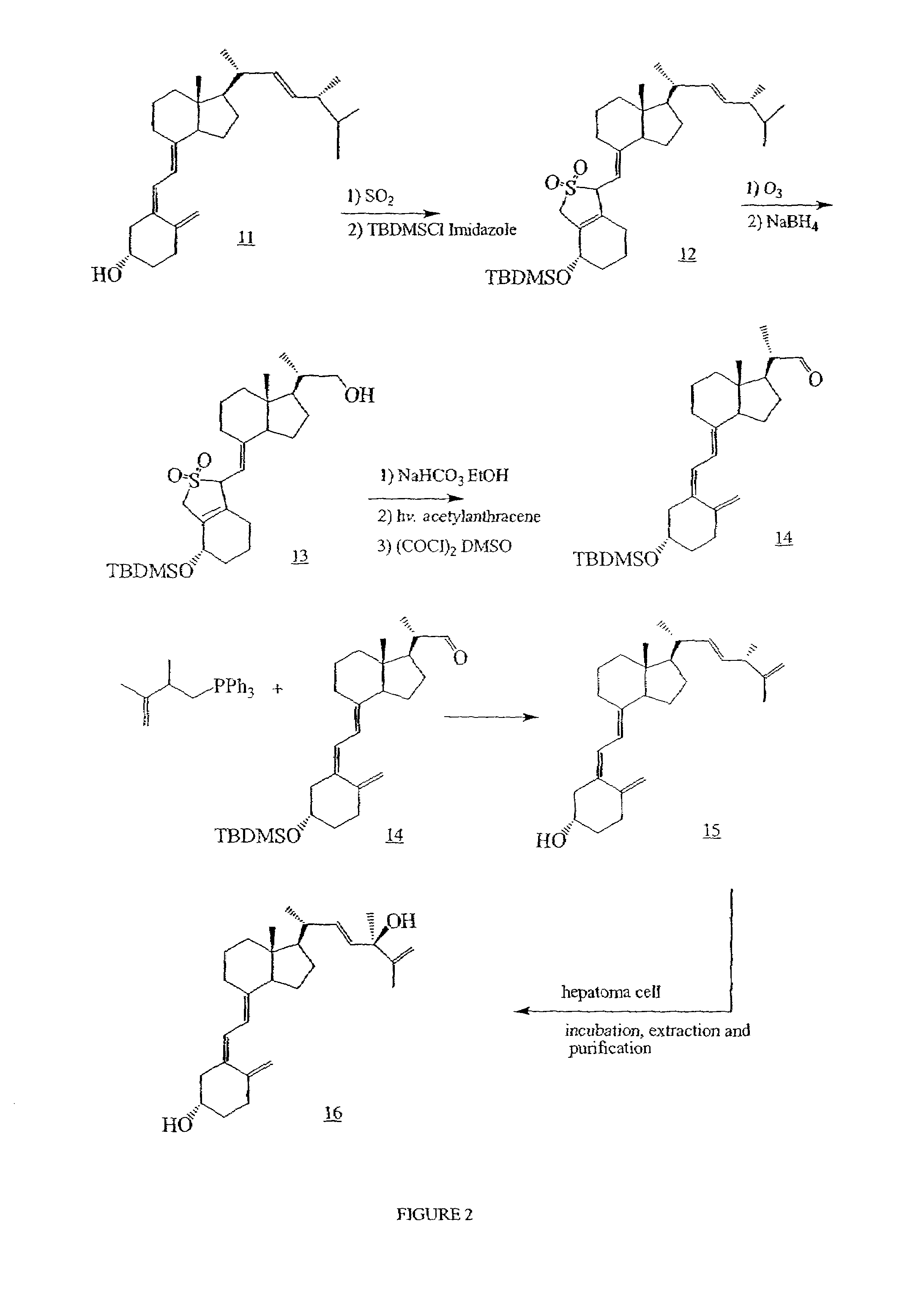24-hydroxyvitamin D, analogs and uses thereof
a technology of vitamin d and hydroxylated vitamin d, applied in the field of 24hydroxyvitamin d compounds, can solve the problems of only being administered hydroxylated vitamin dsub>3 /sub>compounds, causing dangerously elevated blood calcium levels, and achieving equal bioactivity and lowering toxicity
- Summary
- Abstract
- Description
- Claims
- Application Information
AI Technical Summary
Benefits of technology
Problems solved by technology
Method used
Image
Examples
example 1
Synthesis of 24-hydroxyvitamin D2 [24-OH-D2]
(22E)-5,7,22-ergostatriene-3β-yl acetate (2)
[0097]To a solution of 50 gm (0.13 mol) of ergosterol (1) in 300 ml of anhydrous pyridine was added 33.3 ml (0.35 mol) of acetic anhydride. The mixture was stirred at room temperature overnight and then 600 ml of water was added. The precipitate was filtered and washed three times with 200 ml portions of acetonitrile and then air dried to yield 42.0 g (74%) of (2).
22-oxo-5α,8α-(4-phenyl-3.5-dioxo-1,2,4-triazolidine-1.2-diyl)23,24-dinor-6-cholene-3β-yl acetate (4)
[0098]To a solution of 33.0 g (0.075 mol) of ergosterol acetate (2) in 1000 ml of chloroform was added 13.2 g (0.075 mol) of 4-phenyl-1,2,4-triazoline-3,5-dione. The solution of the thus formed (3) was stirred at room temperature for 30 min. and then 5 ml of pyridine was added. The solution was cooled to −78° C. and treated at −78° C. with an ozone-oxygen mixture for 2 hours and then thoroughly purged with nitrogen. Then 50 ml of dimethyl...
example 2
Synthesis of 24(S)-hydroxyvitamin D2 (9) [24(S)-OH-D2]
[0107]Product (8) is subjected to high pressure liquid chromatography (HPLC) on Zorbax-SIL developed with hexane / isopropanol / methanol (91:7:2) or using a reverse-phase Supelco C-8 prep. column (25 cm×21.2 mm; particle size 12 μm) with the solvent system, acetonitrile:water, 60:40, 10 mL / min. The diastereomers (9) and (10) are eluted, and thereby, separated.
[0108]24(S)-Hydroxyvitamin D2 was characterized as follows: optical rotation: [α]D24.0° C.=+120.4 (c=1.0, ethanol); m.p.: 123–126° C.; TLC: Rf=0.10 (4:1, hexane, ethylacetate, silica; Whitman No. 4500-101), elemental analysis: calc'd. c=81.50, H=10.75; found c=81.62, H=10.66. An infrared spectrum (IR) (KBr) is shown in FIG. 3, and an nuclear magnetic resonance (NMR) spectrum (300 MH3, 1H in CDC13) as given in FIG. 4.
example 3
In vivo generation of 1α,24(S)-dihydroxyvitamin D2 [1α,24(S)-(OH)2-D2] from 24(S)-OH-D2
[0109]24-OH-D2 was administered (either oral or intraperitoneal supplementation) to vitamin D-deficient rats. Lipid extracts of the plasma were prepared and the metabolites purified by the method of Horst et al. (Horst, R. L., Koszewski, N. J. and Reinhardt, T. A., Biochem., 29:578–82 (1990) and incorporated herein by reference) described below for synthesizing standard biological 1α,24-(OH)2D2.
[0110]Standard biological 1α,24-(OH)2-D2 was synthesized in vitro from 24-OH-D2 by incubating 10 μg of 24-OH-D2 in flask containing 5 ml of 20% kidney homogenates made from vitamin D-deficient chicks. The product of this reaction was isolated by HPLC and identified by mass spectrometry. In the lipid extracts of the plasma from the vitamin D-deficient rats administered vitamin D2 or 24-OH-D2, one metabolite isolated co-migrated on HPLC with the standard 1α,24-(OH)2D2, indicating that 1α,24-(OH)2D2 is a nat...
PUM
| Property | Measurement | Unit |
|---|---|---|
| temperature | aaaaa | aaaaa |
| bone mass | aaaaa | aaaaa |
| mass | aaaaa | aaaaa |
Abstract
Description
Claims
Application Information
 Login to View More
Login to View More - R&D
- Intellectual Property
- Life Sciences
- Materials
- Tech Scout
- Unparalleled Data Quality
- Higher Quality Content
- 60% Fewer Hallucinations
Browse by: Latest US Patents, China's latest patents, Technical Efficacy Thesaurus, Application Domain, Technology Topic, Popular Technical Reports.
© 2025 PatSnap. All rights reserved.Legal|Privacy policy|Modern Slavery Act Transparency Statement|Sitemap|About US| Contact US: help@patsnap.com



